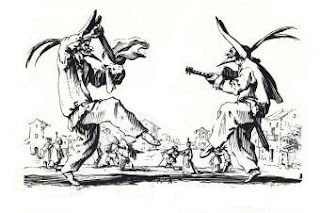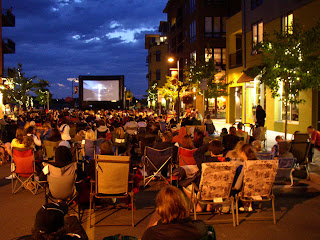Is it really collaborative writing, or fantasy?
 |
| Stock characters in Commedia dell'arte |
Moderately, or potentially ambiguous, this title serves to capture my response to a work of collaborative fiction called The Mongoliad - "a narrative of adventure fiction following the exploits of a small group of fighters and mystics in medieval Europe around the time of the Mongol conquests."
So far as one can tell the work was directed by Neal Stephenson, with the support of Greg Bear, Nicole Galland, Mark Teppo . Other collaborators included "filmmakers, computer programmers, graphic artists, martial artists and combat choreographers, video game designers, and a professional editor."
"Stephenson gathered a group of martial arts enthusiasts interested in studying historical European swordfighting, and this eventually resulted in some of the members of this group collaborating on a set of stories that would make use of accurate representations of these martial arts." (wiki)
Initially there was a serialization deploying a variety of apps (2010-12), then a revised book was published in 2012.
Not being a knowledgeable fan of historical fantasy genre I came across a reference to this "project" while researching connected learning and the MOOC:
"Alternatively, parallels between MOOCs and commercial ventures such as the Massive Open Online Novel (http://mongoliad.com) or the “Indigo MBA” (http://www.chapters.indigo.ca/Indigo-MBA/indigomba-giz.html) argue that there may be potential for revenue generation that do not unduly compromise the free and open nature of the MOOC model." (See: Alexander McAuley, Bonnie Stewart, George Siemens and Dave Cormier, The MOOC Model for Digital Practice, 2010)
If you're interested in this sort of stuff it's worth taking a look at the amazon page which explains the process of team, group and community composition; and the shifts in aesthetic strategy employed at different stages. The 370+ comments on the Amazon page are also an element in the critical co-production, as well as a compendium of multi-faceted insights into the process and the product.
Typically the wikipedia page offers very little in terms of critical evaluation or any controversial commentary on the project. I'd be interested to hear views on whether the book rises above a crude representation of the Mongol as cultural 'other' - displayed and represented purely for the frisson of horror, amusement and consumption offered up as a dainty feast to the American/Western readership.
------------------------------------------------------------------------------------------
Dr Ian McCormick is the author of The Art of Connection: the Social Life of Sentences


Comments
Post a Comment
My blog posts are exploratory rather than finished works. You are invited to add any comments below...